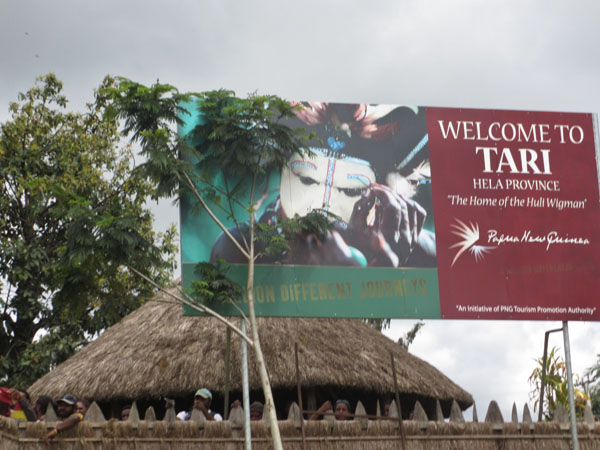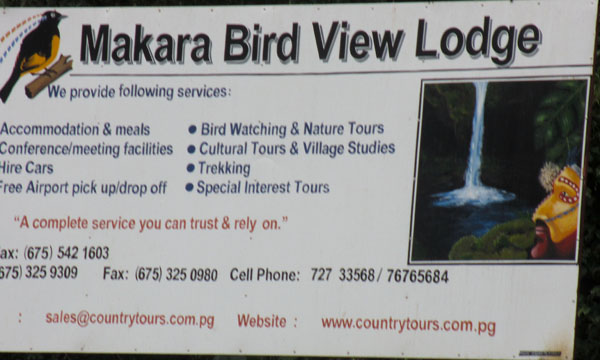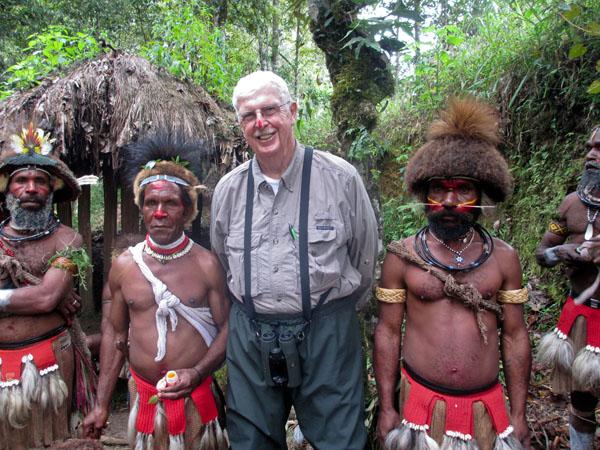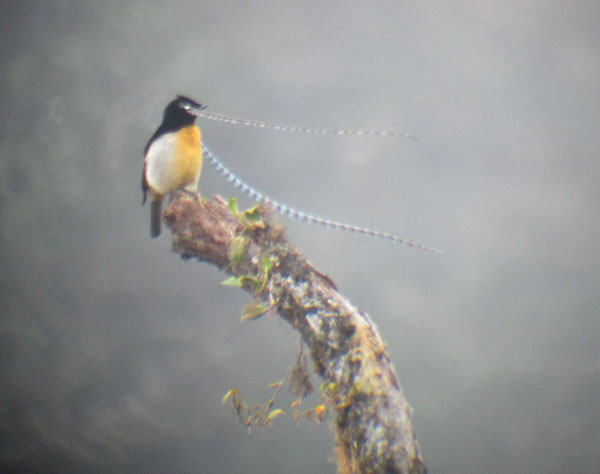On the 25th we flew from Port Moresby to the Tari Valley.

We checked in at the Makara Bird View Lodge. We spent the afternoon birding along the local roads.

It was not until the 1930s that the outside world became aware that there were tens of thousands of inhabitants of this inaccessible (except by air or great effort) highland area. Gold miners from Australia looking for their fortune made their way into the area and did indeed discover gold. There is a documentary entitled “First Contact” that includes footage of the encounter between the explorers and the residents. I have not seen it, but it was described to me by one of our leaders and I plan to try to get a copy and watch it.
The Tari Valley is populated by the Huli Tribe, widely known for their “wigmen” cult. We spent part of an afternoon with a group of Huli Wigmen, adorned in their head pieces made from matted human hair and the feathers of parrots and birds-of-paradise.

The wigmen sleep on their backs with their necks resting on poles to avoid damaging the wig in process.

At 6900 feet of altitude, our lodge had a refreshing mountain climate. Our local guides were very helpful in seeking out some of the rarer and more spectacular birds of the area.
One of our first views was of the lovely King of Saxony Bird of Paradise.

The very long and colorful feathers that protrude from its head are unique in the bird world. This was a very productive site for finding Birds of Paradise. During our stay here we had great views of Superb Birds of Paradise, with their protruding iridescent breast-shield, an unbelievably vivid Blue Bird of Paradise, Ribbon-tailed Astrapias, and Princess Stephanie’s Astrapias.
During our stay here we had to do some shuttling around to find areas that were not shrouded in fog or experiencing a steady but light rainfall. This was accomplished generally by moving up or down the mountain and we usually were able to find areas that were conducive to birding. It was a great place in spite of the weather issues. Among the birds seen at Tari Valley were: a Brown Quail, flushed from the roadside while walking, Bar-tailed Cuckoo Dove, Papuan Mountain Pigeons, Papuan Lorikeets, Plum-faced Lorikeets, Yellow-billed Lorikeets, Orange-billed Lorikeets, Brehm’s Tiger Parrot, Painted Tiger Parrot, Modest Tiger Parrot, Shining Bronze Cuckoo, Brush Cuckoo, Sooty Owl, Marbled Frogmouth, Mountain Owlet-Nightjar, Black-throated Honeyeaters, Marbled Honeyeaters, Common Smoky Honeyeaters, Yellow-browed Melidectes, Belford’s Melidectes, Grey-streaked Honeyeaters, 3 Scrubwren species, Crested Satinbird, Fan-tailed Berrypeckers, Crested Berrypeckers, Black-breasted Boatbills, Great Wood Swallows, Black-shouldered Cicadabird, Black-bellied Cuckooshrike, Black Sittella, Brown-backed Whistler, Regent Whistler, Black-headed Whistler, Long-tailed Shrike, Black Fantails, Friendly Fantails, Dimorphic Fantail, Blue-capped Ifritas, Slaty Robins, Island Leaf Warbler, Papuan Grassbirds, Capped and Papuan White-eyes, Island Thrushes, Hooded Mannikins and NewZealand Pipits.
During our stay at Tari Valley we birded at Mekara Bird View Lodge, at the “Blue BOP” (Bird of Paradise) Village, around the Tari Gap, “Benson’s” Trail and Aduakambe Village. (Benson was our able local guide).
On the morning of the 29th we flew from Tari Valley to Port Moresby where we were expecting to connect with a plane to Mount Hagen. Our troubles with internal flights continued, however, and the Mount Hagen flight was cancelled. We managed to get set up in a much nicer hotel than the first time we were stranded in Port Moresby. Our flight the next morning (the 30th) was delayed and we did not arrive at our Mount Hagen Lodge until early afternoon, in effect losing another day of birding in the whole process.
